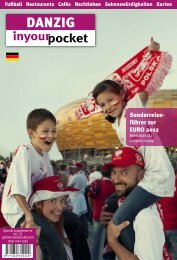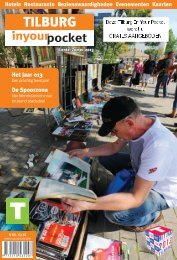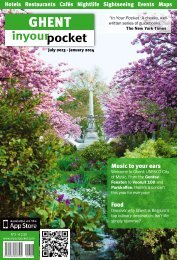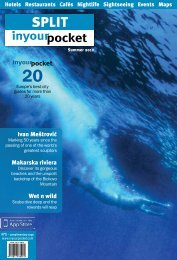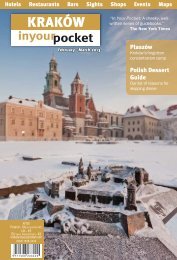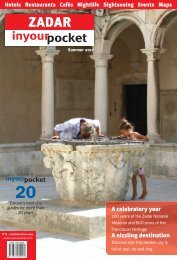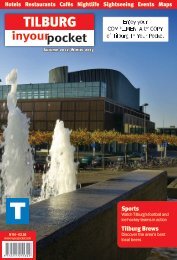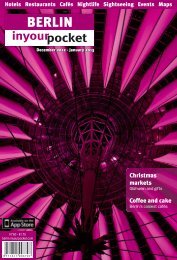7kh 7ul flw\ v prvw dxwkhqwlf 7h[ 0h[ uhvwdxudqw ... - In Your Pocket
7kh 7ul flw\ v prvw dxwkhqwlf 7h[ 0h[ uhvwdxudqw ... - In Your Pocket
7kh 7ul flw\ v prvw dxwkhqwlf 7h[ 0h[ uhvwdxudqw ... - In Your Pocket
Create successful ePaper yourself
Turn your PDF publications into a flip-book with our unique Google optimized e-Paper software.
64 GDAŃSK WHAT TO SEE<br />
Free City Museum<br />
Historical Zone Free City of Danzig<br />
(Strefa Historyczna Wolne<br />
Miasto Gdańsk) B-4, ul. Piwna<br />
19/21, tel. (+48) 602 27 80 51,<br />
www.strefahistorycznawmg.pl.<br />
Situated in a small room off ul. Piwna<br />
what looks like little more than a three minute diversion<br />
transpires to be one of the most fascinating surprises in<br />
the city. From 1920 till 1939 the city you stand in found<br />
life as a semi-independent state, better known as the Free<br />
City of Danzig. This exhibition aims to celebrate those times,<br />
and more specifically the positives that came about. And<br />
there were many; while the rise of fascism will always cast<br />
a pall over the city, it must also be remembered this was<br />
far from the nationalist hotbed that is always assumed. The<br />
campaign for long term Germanization had been reasonably<br />
effective, yet still over 80% of the population regarded themselves<br />
as Danzigers first and foremost - not Germans, and<br />
not Poles, but the citizens of a unique melting pot in which<br />
two nations co-existed. This heyday is remembered by way<br />
of dozens of everyday treasures rescued from the inter bellum:<br />
on show are reams of collectibles, from banknotes to<br />
beer bottles, from tourist guides to cig packets. Of course<br />
it would be impossible to end the story without mention of<br />
the war, and it’s in the back room you’ll find yellowing copies<br />
of newspapers announcing the first salvos, as well as<br />
a small collection of military helmets. As far as diversions<br />
go this is one for the enthusiasts, and soon to be markedly<br />
increased in size thanks to the attic-style donations from<br />
the local public and an expansion next door. QOpen 13:00<br />
- 19:00. Closed Mon. Admission 5/3zł. Y<br />
Four Quarters Fountain<br />
Four Quarters Fountain<br />
(Fontanna Czterech<br />
Kwartałów) C-4, ul. Grobla<br />
I. Long ago you would<br />
have found old Gdańsk<br />
carved into four quarters,<br />
Szeroki, Wysoki, Rybacki<br />
and Kogi (Wide, High, Fish<br />
and Ship quarter) and today<br />
the geographic point where<br />
these historic areas met has<br />
been handily highlighted by<br />
a dazzling installation that<br />
makes use of lions, light and<br />
water. Better known as the<br />
Jerzy Pinkas<br />
www.gdansk.pl<br />
Four Quarters Fountain (Fontanna Czterech Kwartałów),<br />
this smashing piece of street art was officially unveiled<br />
on September 7th, 2009 - more or less seven years after<br />
the initial idea was conceived. Delayed by the discovery<br />
of Gothic age foundations lying below street level, the 2.2<br />
million złoty project was the brainchild of local graduates<br />
and sculptors Ewa Koprowska and Lucyna Kujawa, with<br />
their work funded by Saur Neptun Gdańsk, a Gdańsk<br />
based water and sanitation company. Featuring four life<br />
size lions (ancient symbols and protectors of Gdańsk)<br />
guarding each corner, and glass coloured blocks embedded<br />
into granite panels, what looks questionably naff<br />
during the day transforms at night during the warmer<br />
months when the blocks light up and twenty four jets of<br />
water shoot high into the sky.<br />
St. Mary’s Church (Bazylika Mariacka) C-4, ul.<br />
Podkramarska 5, tel. (+48) 58 301 39 82, www.bazylikamariacka.pl.<br />
St. Mary’s in the Old Town is believed<br />
to be the largest brick church in the world. The interior<br />
vault supports 37 windows, over 300 tombstones and 31<br />
chapels. It can hold up to 25,000 people, which was useful<br />
during the period of martial law between 1981 and 1983<br />
when members of the Solidarity movement sought refuge<br />
here. The church can be accessed through seven gates<br />
with intriguing names like the Purse Maker’s Door. <strong>In</strong>terestingly,<br />
the sculptor who carved the crucifix of Christ nailed<br />
his errant son-in-law to a cross so as to add realism to his<br />
work. St. Mary’s was seriously damaged during WWII and<br />
the original frescoes have since been whitewashed, which<br />
far from leaving an impression of stark emptiness bring out<br />
the best in the relics throughout and creating a marvellous<br />
feeling. Of note is the enormous astronomical clock dating<br />
from 1464. Its complex dials show the time and date, phases<br />
of the moon, the position of the moon and sun in relation to<br />
the zodiac signs, and the calendar of saints. Adam and Eve<br />
ring the bell on the hour. According to legend, the clock’s<br />
creator had his eyes gouged out so he’d never make a clock<br />
to better than this one. You’ll hear this story about every<br />
astronomical clock in Europe, and it makes you wonder why<br />
medieval clock-makers ever accepted commissions. The<br />
78 metre tower houses a viewing platform with cracking<br />
views of old Gdansk. The tower has been the subject of a<br />
recent 3.3 million euro renovation. QOpen 09:00 - 18:00,<br />
Sun 13:00 - 18:00. Admission to tower 5zł.<br />
St. Nicholas’ Church (Kościół Św. Mikołaja) C-3,<br />
ul. Świętojańska 72, tel. (+48) 58 301 35 77, www.<br />
gdansk.dominikanie.pl. The first Catholic church in the city<br />
and the only one to escape WWII without a scratch. Founded<br />
by the Dominican Order in 1348-90, this is a remarkable<br />
church with a dark marbled interior, ancient exposed walls<br />
and a sombre atmosphere. Of note is the multi-level high altar<br />
and Baroque-panelled choir stalls which make it a popular<br />
choice for weddings.QOpen 07:00 - 20:00. No visiting during<br />
mass please.<br />
Monuments<br />
Jan III Sobieski Monument (Pomnik Jana III<br />
Sobieskiego) B-3, Targ Drzewny. A large bronze statue<br />
built in 1897 in memory of the Polish king who reigned in the<br />
17th century and famously defeated the Turks at the gates<br />
of Vienna; thereby saving Europe from the Ottoman hordes.<br />
Originally displayed in Lwow (now Ukranian Lviv), the statue<br />
was moved to Warsaw in 1950 before finally being moved to<br />
Gdansk in 1965. During martial law the statue became the<br />
rallying point for demonstrations and marches.<br />
Józef Piłsudski Monument (Pomnik Józefa<br />
Piłsudskiego) E-4, Pl. Piłsudskiego. Standing outside<br />
the city centre on the main road between Gdańsk and Sopot<br />
is this imposing statue of the inter-war leader of Poland,<br />
Marshall Józef Piłsudski. Despite effectively being a dictator,<br />
Piłsudski remains a hero in this country and represents<br />
for many Poles a true national hero. Designed by Tomasz<br />
Radziewicz, the statue was unveiled on November 11, 2006,<br />
Polish <strong>In</strong>dependence Day.<br />
Monument to the Evacuated Children (Pomnik<br />
Kindertransportu) B-2, ul. Podwale Grodzkie. Between<br />
1938 and 1939 some 10,000 Jewish children were<br />
evacuated from Gdańsk to Britain in what became known as<br />
‘kindertransports’. Sculptor Frank Meisler was one of them,<br />
and on May 6, 2009 his memorial to this exodus was unveiled<br />
outside Gdańsk Główny train station.<br />
Gdańsk <strong>In</strong> <strong>Your</strong> <strong>Pocket</strong> gdansk.inyourpocket.com<br />
Monument to the memory of Poles who lived in<br />
Wołyń (Pomnik Pamięci Polaków Mieszkających<br />
na Wołyniu) C-2, ul. Stolarska. This monument was<br />
built in memory of Poles who were killed by the Organisation<br />
of Ukrainian Nationalists and the Ukrainian <strong>In</strong>surgent<br />
Army during ethnic clashes on Polish Eastern territories in<br />
1943-1945. It was unveiled on the 60th anniversary of the<br />
tragedy - 11 July 2003 as many of the expelled survivors<br />
found themselves in this part of Poland after the conflict. The<br />
motto on the monument says: “If I forget them, God forget<br />
about me” (from the poem by Adam Mickiewicz). The monument<br />
was erected at the request of the World Association<br />
of Home Army Soldiers Volynsky District.<br />
Monument to those who kept Gdańsk Polish<br />
(Tym co za Polskość Gdańska) D-3, ul. Podwale<br />
Staromiejskie. Unveiled in 1969 and designed by<br />
Wawrzyniec Samp and Wieslaw Pietron, this huge stone<br />
monument depicts an axe stuck in the ground and commemorates<br />
all those who gave their lives throughout the<br />
centuries (from the 1308 Gdańsk massacre to WWII) trying<br />
to maintain the Polish identity of Gdańsk.<br />
Museums<br />
Amber Museum (Muzeum Bursztynu) B-4, Targ<br />
Węglowy 26, tel. (+48) 58 301 47 33, www.mhmg.<br />
gda.pl. Housed in Gdańsk’s medieval Fore-gate building<br />
(once home to the Prison Tower and Torture Chamber), this<br />
multi-story exhibit delves extensively into the history of Baltic<br />
amber. The impressive collection of “inclusions” (when bugs<br />
or plants are caught inside the amber) is intriguing to look at,<br />
and the many amber creations, from inkwells to spoons to<br />
a stunning Fender Stratocaster guitar, shows the material’s<br />
diversity. A large open room at the top of the building houses<br />
an impressive array of modern amber jewelry that appears<br />
more artistic than wearable. Many find the separate exhibits<br />
on the building’s past as a torture chamber uncomfortable<br />
- and considering the piped-in soundtrack of pained cries,<br />
we understand why - but they are a must-see, if for no other<br />
reason to find out what “thumb screwing” and a “heretic’s<br />
fork” are. Many of the exhibit rooms throughout the ancient<br />
building are small and cramped, and if you happen to visit on<br />
the same day as a school group it’s a nightmare. Q Open<br />
10:00 - 16:00, Tue 10:00 - 15:00, Sun 11:00 - 16:00. Mon<br />
closed. Admission 10/5zł, family ticket 20zł. Tue free. From<br />
June open 10:00 - 19:00, Mon 10:00 - 15:00, Sun 11:00 -<br />
19:00. Admission 10/5zł, family ticket 20zł. Mon free. From<br />
July open 10:00 - 18:00, Mon 10:00 - 15:00, Sun 11:00 -<br />
18:00. Admission 10/5zł, family ticket 20zł. Mon free. Y<br />
Archaeological Museum (Muzeum Archeologiczne)<br />
D-4, ul. Mariacka 25/26, tel. (+48) 58 322 21 00,<br />
www.archeologia.pl. It might seem strange to find a large<br />
archaeological exhibit on the Sudan in the heart of Gdansk,<br />
faux tribal huts and all, but go with it. The next floors cover<br />
the history of the area, complete with exhumed skeletons,<br />
an ancient canoe and plenty of interesting jewellery that has<br />
been liberated from the ground. More interesting than the Ice<br />
Age weaponry, Stone Age drawings and amber displays are<br />
the models of the city in the past and the detritus collected<br />
after Gdansk was shattered in World War II. With the opening<br />
of more and more modern and visitor friendly museums<br />
in recent years this is both an academic way to spend an<br />
hour of your afternoon and a chance to see what all Polish<br />
museums were once like. Q Open 09:00-17:00, Sat, Sun<br />
10:00-17:00. Closed Mon. From June open 08:00 - 16:00,<br />
Wed 09:00 - 17:00, Sat, Sun 10:00-16:00. Closed Mon.<br />
Admission 8/6zł. Tower 5zł. Family ticket 15zł. Sat free for<br />
permanent exhibition. Guided tour 60zł. Y<br />
gdansk.inyourpocket.com<br />
GDAŃSK WHAT TO SEE<br />
May - July 2012<br />
65



